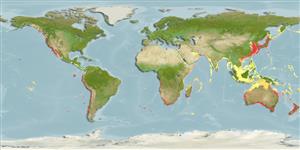Preferred temperature (Ref.
115969): 9.5 - 25.2, mean 17.9 (based on 938 cells).
Phylogenetic diversity index (Ref.
82804): PD
50 = 1.0000 [Uniqueness, from 0.5 = low to 2.0 = high].
Bayesian length-weight: a=0.00871 (0.00715 - 0.01061), b=3.07 (3.02 - 3.12), in cm Total Length, based on LWR estimates for this species (Ref.
93245).
營養階層 (Ref.
69278): 2.8 ±0.1 se; based on diet studies.
回復力 (Ref.
120179): 中等的, 族群倍增時間最少 1.4 - 4.4年 (K=0.45; tm=2; tmax=13-25; Fec=10,000).
Prior r = 0.55, 95% CL = 0.36 - 0.82, Based on 10 stock assessments.
Fishing Vulnerability (Ref.
59153): Low to moderate vulnerability (34 of 100).
Climate Vulnerability (Ref.
125649): Low vulnerability (16 of 100).
